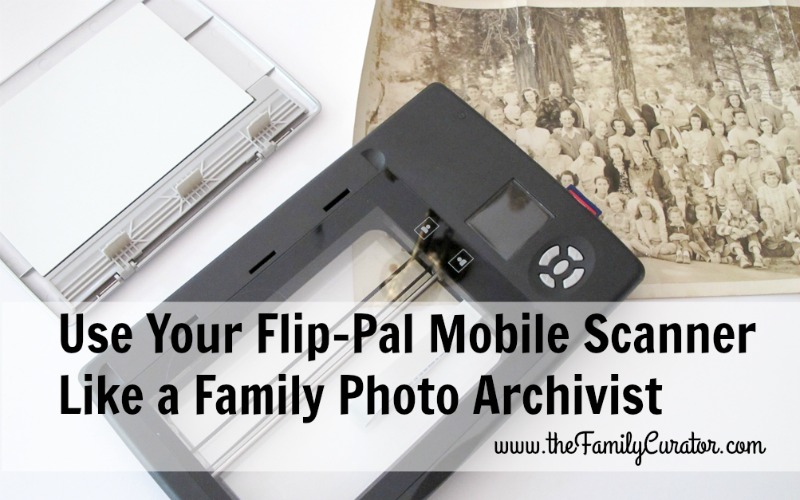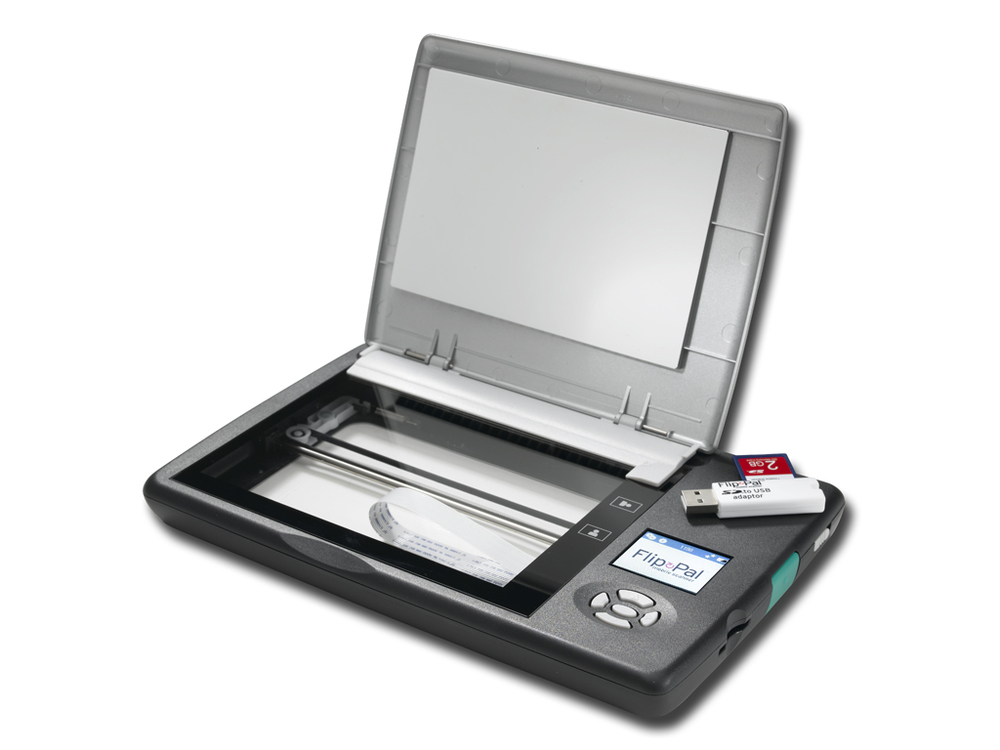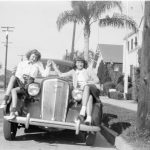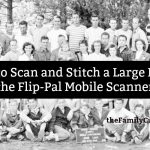 Smartphone cameras are great for family photos and instant-scans, but it’s hard to copy a box of old family photos and read your genealogy email at the same time. And by the time you’re finished with the pictures, your phone’s battery power may be critically low.
Smartphone cameras are great for family photos and instant-scans, but it’s hard to copy a box of old family photos and read your genealogy email at the same time. And by the time you’re finished with the pictures, your phone’s battery power may be critically low.
It’s so frustrating when a relative brings out a wonderful family photo, but doesn’t want to let you borrow it for scanning. Sure, you can snap a smartphone picture or use a digital camera, but a scanned image will be better, especially if the original needs a little photo restoration or digital enhancement. The battery-operated Flip-Pal Mobile Scanner is an ideal travel companion for creating high-quality digital copies of your old family photos.
Flip-Pal Scanner Travel Tips
The Flip-Pal Mobile Scanner easily scans a 4 x 6-inch photo and larger sizes by removing the lid and using the “flip-and-scan” feature. Included software will auto-magically stitch together multiple images to give you one final digital file of the original.
Before You Go
- Take extra batteries and memory card. Rechargeable batteries like the Panasonic Eneloop give more scans per battery.
- Bring a microfiber cloth to clean the glass scanning bed.
- Purchase a pack of 4 x 6 -inch index cards to use in identifying people, events, and places.
As You Scan
- Organize photos by size or event. It will be easier to work with them at home if the images are in meaningful groups for cropping and file naming.
- Use the highest setting, 600 dpi, for photos; use 300 dpi for documents.
- Use the index cards to write captions or identifying information. Write along one side of the card, place it in the margin next to your photo, and scan image and information together. Or, Use a sheet of transparent plastic and an erasable marker to identify people without writing on the photo itself.
- Use the cards to create an Index Image that indicates a new series: Uncle’s Joe’s army pix, 1942-43; Stella’s Wedding, 1 Jan 1952.
After You Scan
- Transfer images to your computer, using the included software to stitch together any oversize images.
- Import images to your photo organization software. Use batch renaming when available to give your images meaningful filenames, for example: brown-arline_1915_wedding_01.
- Perform any edits, including cropping and image enhancement, on a copy of your original JPG file. Save the edited file with a file name like: brown-arline_1915_wedding_01-edited. Or save a set of your original images as an Archive Original.
JPG vs. TIFF File Format
The Flip-Pal scans images in JPG format, a popular and widely-used image format. JPG is useful because the file sizes are not too large; however, it’s also a “lossy” format, so called because the the file is compressed and loses quality and information when it is edited and saved. To avoid this problem, museums and archives use the “loss-less” TIFF format for preservation copies, although the file size will be much larger than a JPG version.
I convert JPG images to TIFF and store these large files on an external hard drive to create Archive Preservation copies of my images. Read about my JPG archive workflow in “Archiving JPG Scans and Photos from Your Flip-Pal Mobile Scanner, Digital Camera, and Mobile Phone”.
Flip-Pal: Whatdoyouknow?
I compared scanned images from the Flip-Pal and my full-size Epson Perfection scanner using the high-quality 600 dpi resolution JPG settings and found that the Flip-Pal scans faithfully reproduced the color, tone, and detail of the original.
The basic Flip Pal comes with an SD storage card and USB adapter containing the Flip-Pal software. Use an EyeFi Mobi card instead of the standard SD card and your scans will be wirelessly transferred to your computer or iPad.
The new Flip-Pal StoryScans feature adds the ability to record mp4 audio files along with your scan using the StoryScans App for Android and iPhone, or with the Flip-Pal computer software and your computer microphone. StoryScans can be purchased with a new Flip-Pal or as an update to an existing model.
The FlipPal Mobile Scanner is available from Amazon.com.
Learn the Secrets to Successful Scanning
Want to learn more about digitizing your family keepsakes and heirloom photos? You’ll find helpful reference charts and guidance in my companion books How to Archive Family Keepsakes and How to Archive Family Photos.
Look for more digitizing techniques:
- Select the best settings for your desktop scanner
- Use a genealogy scanning workflow to streamline projects
- Set up a scanning station
- Choose the right scan resolution
- Use adjustments for color restoration and descreening
- Tips for faster, easier scanning
Note: I purchased the original Flip-Pal in December 2010 and have used it to digitize snapshots, oversize photos, documents, artifacts, newspapers, and microfilm displayed on a reader. It’s one of my favorite tools. Thank you for supporting The Family Curator by shopping with the affiliate links on this website.
This article was originally published in October 2012 and has been updated with new information and resources.







Hello! I just found your article when looking for information about archiving using the Flip-Pal. I was wondering — what do you mean by “a genealogy scanning workflow to streamline projects?” Is this a certain method of working? It sounds like something I could use!
Hi Tina, A “workflow” is just the method you use to do something. Step 1 followed by Step 2, etc. The goal with archiving is to find a workflow that works for you. I have lots of sample ideas and workflows for different situations in my book How to Archive Family Photos. Check out the Book page to read more.
thanks for visiting, Denise
I have included your blog in INTERESTING BLOGS on FRIDAY FOSSICKING at
http://thatmomentintime-crissouli.blogspot.com.au/2016/11/friday-fossicking-18th-nov-2016.html
Thank you, Chris
Love this article!!!! It’s now a resident in my Evernote Help Desk notebook so I can get to it whenever I need it. –Denise
Thanks, Denise! Remember those extra rechargeable batteries!
I have scanned photos as TIFFs then again as a JPEG. It’s so time-consuming though. How well do PNGs hold up in comparison to both these?
Leslie – There’s really no need to scan items twice. It’s actually better to only scan once and expose your photos or documents to the scanner light one time. Your photo editing software or image viewer should be able to convert image files between formats. Look under the Save As or Export command for the option to Save in other formats.
To answer your question about PNG files: this format was introduced largely to replace GIF format but it is also loss-less, like TIFF. At the current time most archives still recommend using TIFF format, however this may change as more browsers and programs become compatible with PNG.
Hi Denise,
I put my pictures on Picasa 3. When Google gave up on Picasa I seem to be unable to send pictures on an email as I had been able to do before. They are repeated on other sites but I liked Picasa because it was easy to use. Just highlightted a pic, went to email at the bottom of the page and sent it. Is it Googles fault or operator effor?
Bill Miller
Hi Bill – You are so right about Picasa being easy to use, until Google stopped supporting it. You may be having trouble emailing from the program because newer computers and software have grown past Picasa’s 32-bit limits. This webpage gives more information about using Picasa’s email service with a 64-bit mail program (which is probably what most of us use these days) and suggests a few email workaround solutions: https://sites.google.com/site/picasaresources/Home/Picasa-FAQ/picasa/troubleshooting/i-cannot-email-picture-from-picasa-anymore.
So, not “operator error” at all :>) ~ Denise
Hi Nancy, I didn't go into detail for JPG to TIFF conversion because each photo editing program is slightly different. Look at the Export, Save As, or Convert to commands in your current software. A drop-down menu usually gives the option for various file formats.
What photo editing software do you use? I'll be happy to help you figure out how to convert the files.
Have you already told us how to convert a JPG to a TIFF file? Did I miss it? Do I need a special program to make the conversion? Thanks for the help.